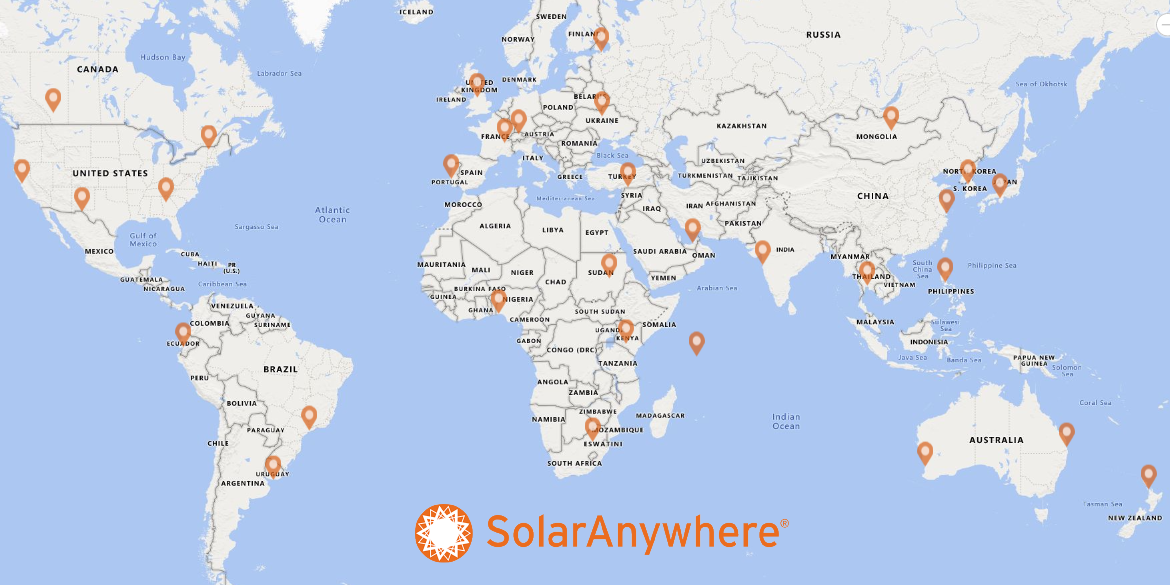Recognizing the value of solar resource data to growth and innovation, Clean Power Research® is pleased to offer SolarAnywhere® Public, a no-cost solar data service that offers high-fidelity, complete and current solar irradiance and weather data for more than 30 locations around the globe.
Better data, better models
As the solar industry continues to advance applications for solar data, better data is necessary to build better models. More accurate solar models, in turn, help reduce performance and financial risk, leading to greater solar investment and growth.
SolarAnywhere Public gives students, researchers and the solar industry open access to complete and current time-series irradiance and weather data—the first offering of its kind. These data will aid in researching new and improved solar PV models for risk assessment, operations and maintenance, intelligent energy dispatch and more, and complement community-driven, open-source PV modeling projects such as pvlib. SolarAnywhere Public also can be used to train a burgeoning solar workforce to help accelerate the deployment of solar PV solutions across the industry.
A new no-cost solar data offering for a maturing solar industry
Clean Power Research has historically supported the solar community by providing irradiance data at no cost to users with an Academic license. SolarAnywhere Academic offers access to NREL and CPR/SUNY’s Solar Prospector solar resource data for academic studies and project feasibility analysis. This legacy dataset was generated using older SolarAnywhere data versions and is only available for locations in the U.S.
As the solar industry continues to evolve, so do its needs. Solar resource assessments and performance monitoring are becoming more data hungry, sophisticated and accurate. To support this growing need, Clean Power Research is the first to offer complete and accurate time-series solar data updated through the trailing day at select locations.
In contrast to other free solar data sources that may be limited in availability to static typical year or certain geographies, SolarAnywhere’s unique offering includes on-demand access to current and complete datasets at popular locations across the globe, including:
- Enhanced resolution (1km, 15 minute) time-series solar and weather data updated through trailing day for PV performance and battery modeling
- Probability of exceedance (PXX) data for weather risk assessment
- Precipitation data for system loss modeling
- Typical GHI year (TGY) data for initial, high-level assessment of solar resource availability at a project location
- And much more
SolarAnywhere Public goes global
SolarAnywhere Public is offered at diverse geographical locations ranging from Guayaquil, the largest city in Ecuador, all the way to Seychelles, one of the world’s smallest countries. Public data sites also are interspersed across the Northern and Southern Hemispheres, covering cities such as St. Petersburg, Russia in the North, to São Paulo, Brazil and Auckland, New Zealand in the South.
With complete and current SolarAnywhere Public data, it’s possible to get detailed insights into the solar resource and PV potential at these locations. For example:
- Estimating snow losses in Canada – For PV systems installed in snowy climates, the accumulation of snow on PV panels can result in energy production losses, referred to as “snow losses.” Site-specific, time-series solar data can help solar financiers and owners reduce uncertainty in snow loss estimates. Using SolarAnywhere Public, we estimated snow losses for an arbitrary, fixed-tracking PV system installed at latitude-tilt in Calgary, Canada. The analysis revealed that downside (P90) snow losses could reach as high as 10%.
- Understanding smoke impacts in Australia – Bushfires rampaged parts of Australia in what is known as the ‘Black Summer’ of 2019-2020. By modeling clear sky direct normal insolation (DNI)—the direct sunlight on a cloudless day—it’s possible to illustrate the length and severity of the wildfire season. Using SolarAnywhere Public clear sky irradiance data, we looked at how smoke impacted sunlight availability at Brisbane, Australia for the period of January 2020. Compared to the long-term average for the same month in the period of 2006-2019, we found that the clear-sky DNI was reduced by nearly 11% at that location.
Each SolarAnywhere Public location includes a 3×3 grid of 1 km tiles with a featured city landmark, making it possible to explore the solar potential in places such as:
- Estadio Centenario in Montevideo, Uruguay
- Mahalaxmi Race Course in Mumbai, India
- Nairobi National Museum in Nairobi, Kenya
- Osaka Castle in Osaka, Japan
- Parc de la Tête d’Or in Lyon, France
- Sheikh Zayed Stadium in Abu Dhabi, United Arab Emirates
- Twin Peaks in San Francisco, United States of America
Start exploring!
With SolarAnywhere Public, solar researchers and industry stakeholders can test the full range of data available for solar resource assessments and performance monitoring at no cost. To find the complete list of SolarAnywhere Public locations (with more locations expected soon), register for a SolarAnywhere Public license at data.solaranywhere.com and start exploring.
